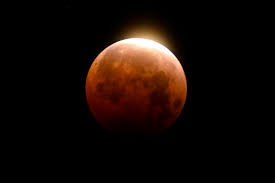
The Moon had the nearest approach to Earth on May 26 and therefore appeared to be the closest and largest Full Moon or “supermoon” of 2021.
Daily Current Affairs Quiz 2021
The celestial event coincides with this year’s only total lunar eclipse, the first since January 2019. Significantly, a supermoon and a total lunar eclipse have not occurred together in nearly six years.
A supermoon occurs when the Moon’s orbit is closest to the Earth at the same time that the Moon is full. According to NASA, the term supermoon was coined by astrologer Richard Nolle in 1979.
As the Moon orbits the Earth, there is a point of time when the distance between the two is the least (called the perigee when the average distance is about 360,000 km from the Earth) and a point of time when the distance is the most (called the apogee when the distance is about 405,000 km from the Earth).
Now, when a full Moon appears at the point when the distance between the Earth and the Moon is the least, not only does it appear to be brighter but it is also larger than a regular full moon. In a typical year, there may be two to four full supermoons and two to four new supermoons in a row.





